
Original Link: https://www.anandtech.com/show/2323
AMD Phenom Preview: Barcelona Desktop Benchmarks
by Anand Lal Shimpi on September 10, 2007 12:03 AM EST- Posted in
- CPUs
The last time we had a turn around like this was when NVIDIA launched the GeForce FX. NVIDIA gave us a weekend, Superbowl Weekend to be exact, to review its latest GPU back in 2003. History was bound to repeat itself, and this time it was AMD keeping us occupied all weekend.
We got a call earlier in the week asking if we'd be able to turn around a review of AMD's Barcelona processor for Monday if we received hardware on Saturday. Naturally we didn't decline, and as we were secretly working on a Barcelona preview already, AMD's timing was impeccable.

What we've been waiting for
AMD shipped us a pair of 2U servers a day early, we actually got them on Friday but being in Denver at CEDIA we couldn't begin testing until Saturday. Luckily, Johan had Barcelona in Europe for over a week by this point and was already hard at work on server benchmarks. I augmented Johan's numbers with some additional results on these servers, but I had other plans in mind for the Barcelona system that AMD was sending me.

We went from no Barcelona, to fist-fulls of Barcelona in one weekend
You see, we've known for a while that Barcelona was going to do well for AMD on the server side. AMD is far more competitive there than in the desktop market, mostly thanks to its Direct Connect architecture, something Intel won't be able to duplicate until the end of 2008 with Nehalem. Barcelona will improve clock-for-clock performance over Opteron and is a drop in replacement for Socket-1207 servers with nothing more than a BIOS update; the Enterprise world couldn't be happier.
Things are different on the desktop; AMD hasn't been competitive since the launch of Core 2 in the Summer of 2006 and we're very worried that even after Phenom's late-year launch, the market still won't be competitive. While that's great for consumers today, the concern is that a non-competive AMD will bring about a more complacent Intel, which we do not want. We want the hungry Intel that we've enjoyed for the past year, we want ridiculous performance and aggressive pricing, and we won't get that without an AMD that can fight.
But AMD won't tell us anything about how Phenom will perform, other than that it will be competitive with Conroe/Kentsfield. So the goal here today is to get an idea of exactly how much faster Barcelona (the same core that'll be in Phenom X4) will be compared to the Athlon 64 X2.
We'll have more Barcelona server content coming as we spend more time with the system, but be sure to check out Johan's coverage to get a good idea of how Barcelona will compete in its intended market. If you're not familiar with Barcelona/Phenom architecture, or if you're confused as to exactly what Phenom is here's some required reading before proceeding.
2.0GHz Today, 2.5GHz Tomorrow
At the last minute, AMD informed us that we'd be receiving three sets of Barcelona processors: a pair of 1.9GHz chips, 2.0GHz chips and 2.5GHz chips. The latter won't be shipping until Q4 of this year, but AMD wanted to show that Barcelona is yielding at higher clock speeds and that there is a roadmap going forward.

Barcelona - 1.9GHz

Barcelona - 2.0GHz
To be honest, we expected 2.5GHz by the end of year from AMD, and slightly higher on the desktop but it's good to actually have silicon in hand instead of empty promises or hunches.

AMD taking notes from Intel, hand written clock speeds are in.
With 2.5GHz in hand today, we'd expect Phenom to be at or below 2.6GHz by the end of the year, with 3.0GHz coming sometime in 2008.
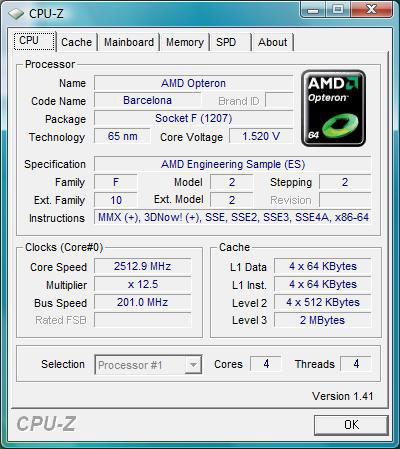
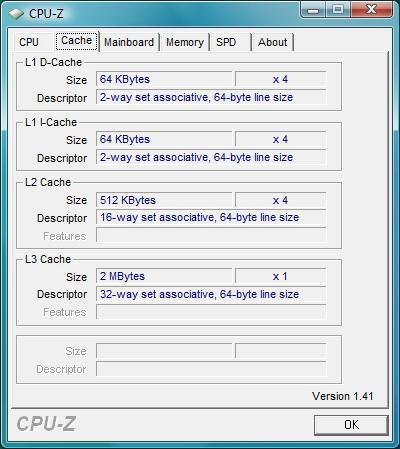
The Servers
AMD was kind enough to send us two servers, identically configured, from Colfax. The configurations were as follows:
| AMD | Intel | |
| Motherboard | Supermicro H8DMU+ | Supermicro X7DBE+ |
| BIOS Revision | DMU8157v3.ROM | R1.3C |
| CPU | 2 x Opteron 2350 (2.0GHz) | 2 x Xeon 5345 (2.3GHz) |
| Memory | 8GB (8 x 1GB DDR2-667) | 8GB (8 x 1GB FBDIMM-667) |
| Hard Disk | 1 x Seagate Barracuda ES (400GB) | 1 x Seagate Barracuda ES (400GB) |
| Power Supply | 700W Redundant | 700W Redundant |
| OS | Windows Server 2003 SP1, 64-bit | Windows Server 2003 SP1, 64-bit |
These are standard Socket-1207 servers, meaning they don't take advantage of the split power-planes of Barcelona. Newer motherboards (such as the one Johan used in his tests) will support split power-planes, allowing Barcelona to run its North Bridge at a higher clock frequency, thus improving memory performance. Note that our desktop benchmarks were run under Windows Vista Ultimate (32-bit). Update: AMD has confirmed that these motherboards are Socket-1207+ and thus support split power-planes. We apologize for the error.
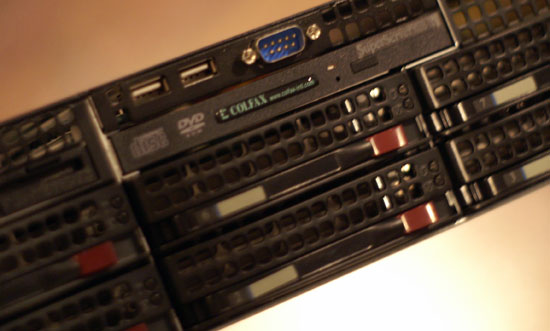
2U Colfax server

Colfax Intel Server
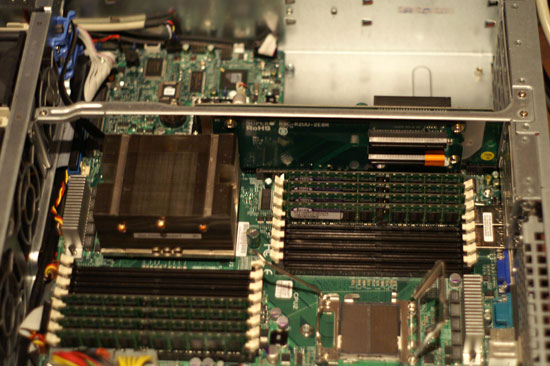
Colfax AMD Server, one CPU removed
Both systems worked just fine, but we did spend more time with the AMD system (obviously). During our testing we'd occasionally get a Hyper Transport error upon reboot, but it was intermittent and didn't interfere with our results:
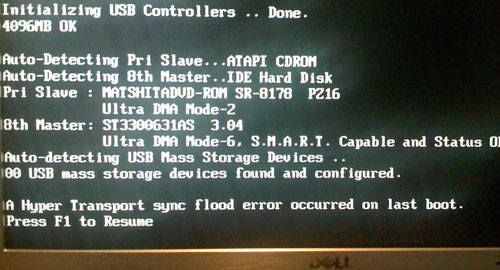
Then, at the very end (literally two hours before publication) of our benchmarking, the AMD server stopped POSTing. As of now the system will simply sit there and spin its fans without actually putting anything on the screen. A number of things could have happened, but thankfully the Barcelona system decided to die after we ran all of our tests.
The take away point here is that AMD is working as quickly as possible to push out this Barcelona release. While AMD states to expect availability as early as today, we're concerned about the maturity of these platforms. We got our test systems on Friday, if this were truly a large, widespread launch we would've had hardware long ago. Whereas everyone and their mom already has a sample of Intel's 45nm CPUs, Barcelona continues to be tough to come by and performance hasn't been anywhere near final until now.
Logistics aside, we now have final silicon in hand (and a dead server on our floor), so let's see what we can do.
The Methodology
We've been asking AMD for months now to let us benchmark Barcelona and Phenom, and for months we've gotten the same answer: not yet. When asked why, AMD would always give us some terrible lie about how it was for competitive reasons, but when we actually put our hands on Barcelona at Computex we realized that these chips were simply not ready.
The Barcelona launch is finally upon us and we've got to wait another 45 - 60 days before we'll be able to bring you a review of Phenom, well, not exactly. Back when the Opteron launched, AMD was in a very similar situation to the one it's in today; AMD needed K8 to remain competitive, and it had been delayed so much that we were beginning to wonder if AMD would ever get the chip out on time. When the K8 finally launched, it was server-only but we took one of those server-only motherboards and ran a bunch of desktop tests on it to predict forthcoming performance.
We cracked open the Barcelona server and made some modifications; while the on-board ATI ES1000 graphics is sufficient for use as a server, it'd be too limiting for our desktop benchmarks. Luckily the Supermicro motherboard in the system had a plethora of PCIe slots, we just needed to gain access to them.
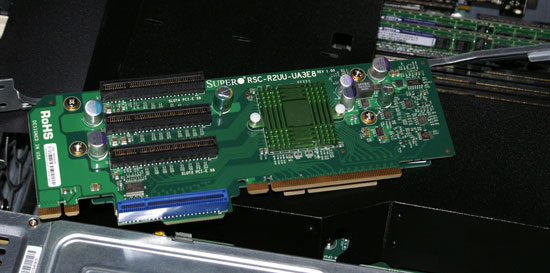
The PCIe Riser we removed from the system
We pulled out the PCIe riser card which plugs into the motherboard's sole x16 slot and divides it into a pair of x8s, then we modified a GeForce 8800 GTX by removing the backplate cover so we could just stick it into the open server.
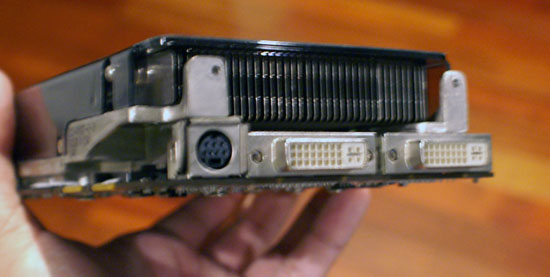
The modded 8800
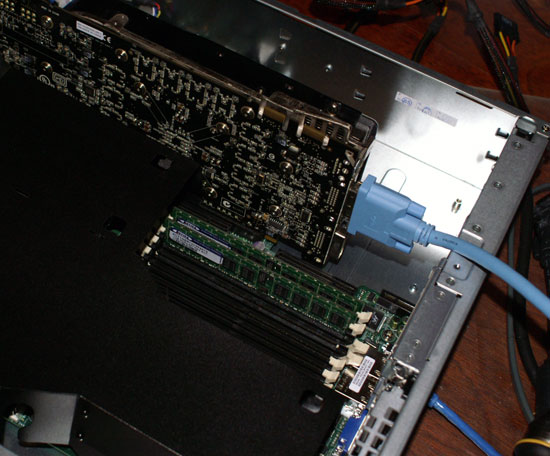
The 8800 GTX installed, the server is not really intended to be used like this
The end result was, as Johan put it, us using "such a beautiful, noble machine for such plebian activities". We couldn't help it, while AMD has already contacted us about Phenom briefings, we couldn't wait that long to get an idea of what we can expect from AMD on the desktop.
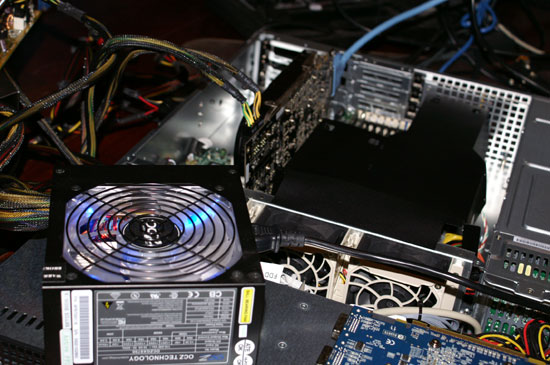
We needed an external PSU to power the graphics card, the server didn't have any PCIe power connectors
Barcelona is currently limited to DDR2-667, we were unsuccessful with attempts to run the memory any faster. Like all other MP Opterons, Barcelona requires the use of registered DDR2 memory, which is inherently slower than the unbuffered stuff we use on desktops. Because of these limitations we refrained from running any comparative benchmarks to desktop Athlon 64 X2s, instead we chose to run a single quad-core Opteron in our server platform against a pair of dual-core Opterons to simulate Phenom vs. K8 on the desktop.
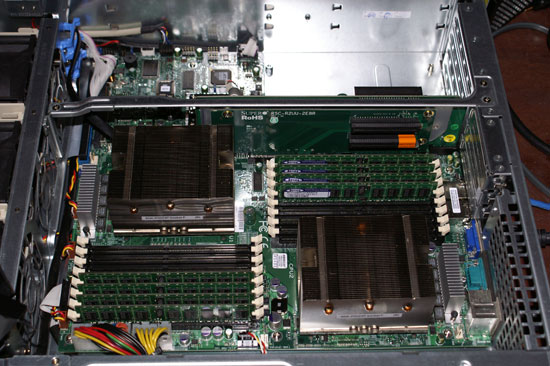
The Opteron server, 2 CPUs, 8 DDR2-667 DIMMs
Keep this in mind as you're looking at these results, at best all we're offering is an idea of, at a minimum, how much faster Phenom will be over an identically clocked Athlon 64 X2. As Phenom is a more data hungry CPU than its predecessor, it will rely more on having a faster memory subsystem so the performance improvement could be even greater when we measure it on the desktop. That being said, at least we can set expectations within some amount of reason by performing this investigation.
K8 vs. Barcelona: The Phenom Preview
With the test methodology explained, how does Barcelona stack up to a pair of dual-core Opterons? In other words, how much faster can we expect Phenom to be vs. the Athlon 64 X2? To put it succinctly, it looks like around 15% clock for clock:
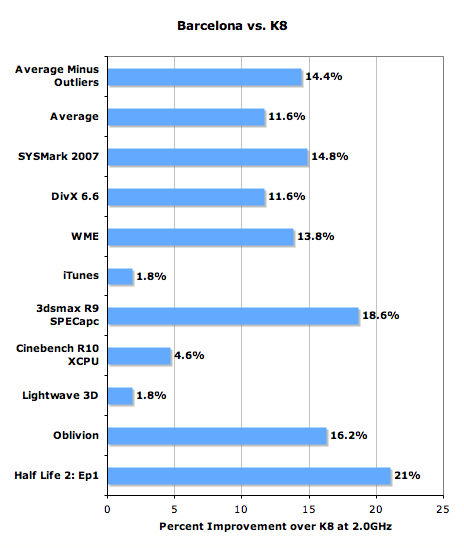
Clock for clock there's nothing short of a huge increase in performance over the K8 based Opterons in SYSMark 2007. The E-Learning and Video Creation tests are both around the 20% mark, while 3D rendering drops to a 12% advantage, but the productivity suite sees almost a 30% increase in performance thanks to Barcelona. The overall improvement in SYSMark 2007 ends up being 15%.
In fact, the average performance improvement of Barcelona over K8 ends up being 11.5% and 14.3% if we exclude the two 1.8% outliers in our data.
Johan's article showed that Barcelona in the enterprise world is competitive, but on the desktop our data indicates that AMD won't be upsetting Intel anytime soon. Even at 2.6GHz, a 15% boost in overall performance won't be enough to dethrone Intel, but with competitive pricing AMD could actually be a real alternative again.
We have no idea how AMD will price Phenom, but as we suspected, it may be the pricing that ends up deciding how competitive Phenom is.
Barc Scaling: 2.0 vs. 2.5GHz
With two significantly different clock speeds on hand, we wanted to see how Barcelona performance would scale once AMD starts shipping at higher frequencies. At 2.5GHz we're running at a 25% higher clock speed than the 2.0GHz Barcelona, the chart below shows what performance improvement you get for the 25% increase in clock speed. Just as before, the benchmarks run are our standard CPU tests with the exception of the gaming benchmarks which are run at 1024 x 768 to ensure that they are CPU bound:

Even limited by its DDR2-667 memory subsystem, Barcelona scales well with clock speed. Windows Media Encoder, 3dsmax and Cinebench all scale almost perfectly with clock speed, and the rest of the tests aren't that far behind. Remember when we heard at Computex that Barcelona will really be competitive at higher clock speeds? It looks like this initial scaling data supports that theory, especially because Intel is very close to not shipping any mainstream desktop parts below 2.0GHz.
Final Words
We can't draw too many sweeping conclusions based on the data here today, but here's what we do know:
- Gaming performance is much improved with Barcelona over K8, this is most likely a result of the improvements to the SSE engine and the wider front end of the core.
- Encoding performance is improved (again SSE128 rearing its head), but 3dsmax saw an unexpectedly large performance improvement.
- With a 10 - 15% increase in performance on average, Phenom should be more competitive than K8 was on the desktop (as expected).
Here's where things get complicated; we knew Phenom/Barcelona would be faster clock for clock, it was only a matter of how big of an improvement we'd get. If we are to believe that 15% is the best we'll get on average, taking into account that Penryn is around 5% faster than Conroe, the updated architecture from AMD alone isn't enough to really compete with Intel. In other words, price matters.
We saw how competitive AMD became after the first round of price cuts this year, but after the second set Intel went back to dominating. The trouble for AMD this time around is that Phenom is a much larger chip than the outgoing Athlon 64 X2, whereas Intel's Penryn family will actually be smaller than Conroe. AMD is already losing a considerable amount of money each quarter, so fabbing a larger chip at the same price as current CPUs will only make the situation worse. However, Intel can afford to continue to keep its processors as aggressively priced, especially moving to 45nm.
To put it plainly: Phenom/Barcelona make this price war more difficult on AMD, while Penryn makes it easier on Intel. What's the end game? Is there a solution? We're not sure, all we know today is a starting point for Phenom expectations.







